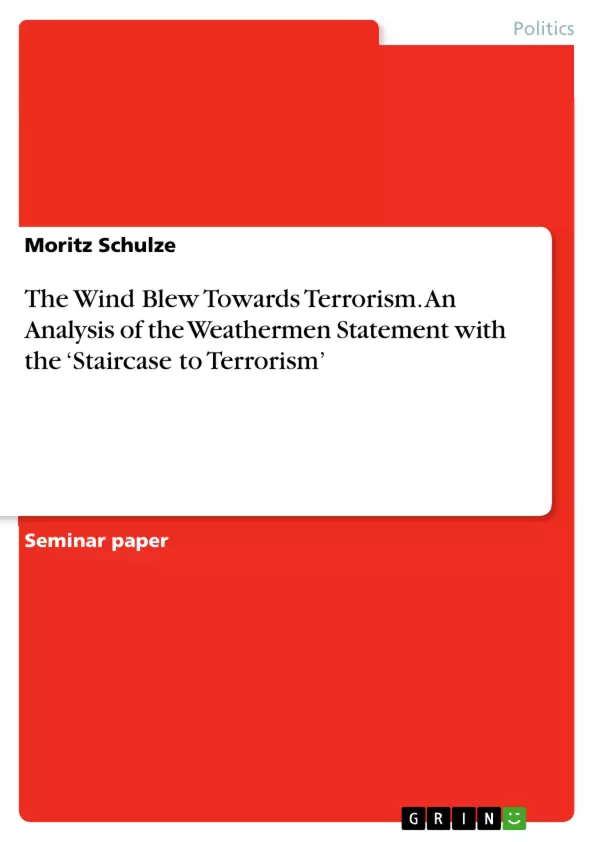This term research paper will take a step back and take a closer look at an organization known as the “Weather Underground”, which was involved in a number of bombings and other domestic attacks during the end of the 1960s and the 1970s. Beginning with an introduction and an overview of the “Weather Underground Organization” (WOU) that will focus on its origins, formation, actions and dissolution, this paper will analyze the WUO by using a model that contextualizes radicalization as a process and is known as the “Staircase to Terrorism”.
The six floors, of which the model consists of, will further be individually substantiated by passages of the “Weathermen Statement”8, the first publication of the Weather Underground, and exemplary actions that the organization planned from 1969 until its dissolution in 1977.
The conclusion and the concluding statement at the end of the paper will reason for the suitability of the “Staircase to Terrorism” as well as its limitations and will further point out potential approaches for continuing research.
Table of Contents
- 1. Introduction
- 2. A Historical Overview of the Weather Underground Organization
- 2.1. Origins
- 2.2. Formation of the Weather Underground
- 2.3. Actions and Attacks
- 2.4. Dissolution
- 3. The Staircase to Terrorism
- 4. The Staircase to Terrorism in the Weathermen Statement and their Actions
- 4.1. Ground Floor: Psychological Interpretation of Material Conditions
- 4.2. First Floor: Perceived Options to Fight Unfair Treatment
- 4.3. Second Floor: Displacement of Aggression
- 4.4. Third Floor: Moral Engagement
- 4.5. Fourth Floor: Solidification of Categorial Thinking and the Perceived Legitimacy of the Terrorist Organization
- 4.6. Fifth Floor: The Terrorist Act and Sidestepping of Inhibitory Mechanisms
Objectives and Key Themes
This research paper analyzes the Weather Underground Organization (WUO), a group responsible for several bombings and attacks in the late 1960s and 1970s. It utilizes the "Staircase to Terrorism" model to contextualize the WUO's radicalization process, examining their actions in light of the model's six stages. The paper aims to assess the model's applicability and limitations while suggesting avenues for future research.
- Origins and development of the Weather Underground Organization.
- Analysis of the Weathermen Statement and its connection to the group's actions.
- Application of the "Staircase to Terrorism" model to understand the WUO's radicalization.
- Examination of the WUO's actions and their impact.
- Evaluation of the "Staircase to Terrorism" model's strengths and weaknesses.
Chapter Summaries
Chapter 1: Introduction provides background on terrorism and introduces the Weather Underground Organization as the focus of the study. Chapter 2: A Historical Overview of the Weather Underground Organization details the origins of the WUO from the Students for a Democratic Society (SDS), its formation, key actions (including the "Days of Rage"), and eventual dissolution. Chapter 3: The Staircase to Terrorism introduces the theoretical framework used in the analysis. Chapter 4: The Staircase to Terrorism in the Weathermen Statement and their Actions applies the model to the WUO, examining specific statements and actions in relation to each stage of radicalization.
Keywords
Weather Underground Organization, Weathermen, Terrorism, Radicalization, "Staircase to Terrorism" model, Students for a Democratic Society (SDS), domestic terrorism, 1960s, 1970s, political violence, anti-imperialism.
- Arbeit zitieren
- Moritz Schulze (Autor:in), 2023, The Wind Blew Towards Terrorism. An Analysis of the Weathermen Statement with the ‘Staircase to Terrorism’, München, GRIN Verlag, https://www.grin.com/document/1478771



